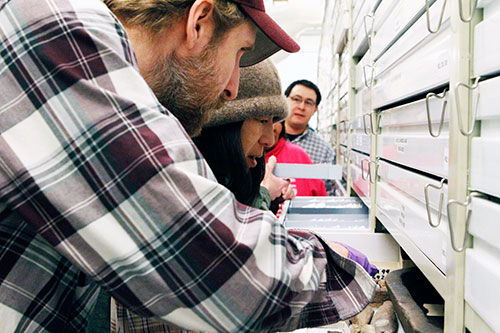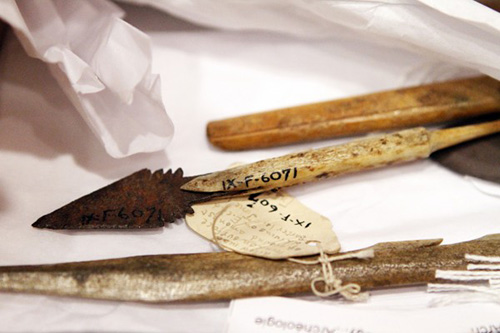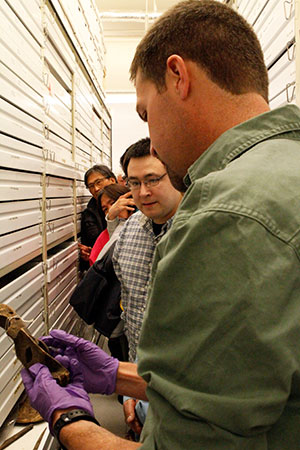
Return of artifacts fulfills century-old promiseBy THERESA BAKKER
June 03, 2015
The artifacts excavated at Barter Island were preserved at the Canadian Museum of History after being collected by Diamond Jenness in 1914 as part of the Canadian Arctic Expedition. Now on loan to the university museum in Fairbanks, the collection recently was accessed by Chumis Cultural Resources Services, Northern Land Use Research Alaska and the museum to fulfill part of a cultural resources agreement outlined under ExxonMobil’s Point Thomson Project.
From left, UA Museum of the North Archaeology Curator Josh Reuther and Kaktovik resident Marie Rexford examine ivory and bone artifacts in the Barter Island collection Members of the Kaktovik community have worked closely with archaeologists to examine the artifacts, learn from them and involve their children in an effort to support future collaborations with researchers. Matthew Rexford of the Native Village of Kaktovik said this partnership is especially important for the community’s youth. “Starting them when they are young will be really helpful in deciding what they would like to pursue in their life. So, I think looking to our past to learn from, it is key,” he said. Gina Dickerson, senior project manager for the Point Thomson Project, said helping preserve the cultural heritage of the Alaska Native community is a primary focus of ExxonMobil Alaska. “This agreement was a creative approach to work directly with the Kaktovik community to realize a long-standing desire to reconnect with these collections.” The Barter Island collections represent a remarkable period from before and just at the beginning of contact with Euro-American whalers and explorers, Jason Rogers of Northern Land Use Research Alaska said. “There are a wide variety of artifacts that represent changes in material culture, including antler arrowheads and ivory harpoon heads with iron points, as well as copper and slate ulus."
These arrowheads, on loan to the University of Alaska Museum of the North from the Canadian Museum of History, were collected by Diamond Jenness in 1914 on Barter Island, Alaska.
The collection arrived in Fairbanks in October 2014 after an agreement was finalized to loan the artifacts to the museum. Since then, in-depth documentation and analysis of the artifacts has been ongoing, enhancing previous work completed by Jenness and other researchers in collaboration with North Slope community members. “These collections made by Jenness in 1914 were some of the first real scientific archaeology ever done in Alaska,” Reuther said. “The materials would have likely been lost to erosion or destruction through development. Now more than 100 years later, the preservation and study of these collections is providing new insights into the unwritten history of this region.” Members of the Kaktovik community have been instrumental in interpreting the items returned to Alaska. Chris Wooley, Chumis Cultural Resource Services, said their traditional knowledge has helped to provide a richer context to scientific studies of the collection — one built on an early but very sound collaborative foundation. “The focus of this collaborative analysis is to better understand Barter Island history and prehistory and facilitate an ongoing Inupiat cultural revitalization across the North Slope,” he said. “The analysis will be summarized in an updated report with extensive artifact photos and 3-D scans that will incorporate this traditional local knowledge with scientific information gathered over the past century.” The archaeologists wanted to follow the lead of Jenness, Hall and North Slope Borough elders, who originally intended to bring the traditional and scientific knowledge gained from these collections back to the North Slope Inupiat community. Now, the collection will be more easily accessed by the community of Kaktovik where it originated, Wooley said. “This project is reinvigorating local cultural pride and sparking research interest in an extremely significant collection.” The collection played a key role in the growth and basic knowledge of circumpolar archaeology in North America in 1914 and was an early example of scientific collaboration with local experts. The current project’s melding of science and traditional knowledge is in keeping with the flavor of the initial excavation, showing how collaborative efforts can bring new life and understanding to a 100-year-old collection. “It is our privilege to be a part of this important and exciting work,” said Karen Hagedorn, production manager with ExxonMobil Alaska. “We appreciate all the efforts of our partners and everyone involved in bringing this vision to life.”
This article is provide as a public service by the University of Alaska, Museum of the North. THERESA BAKKER [tabakker@alaska.edu] is an information officer with the University.
|
|||


